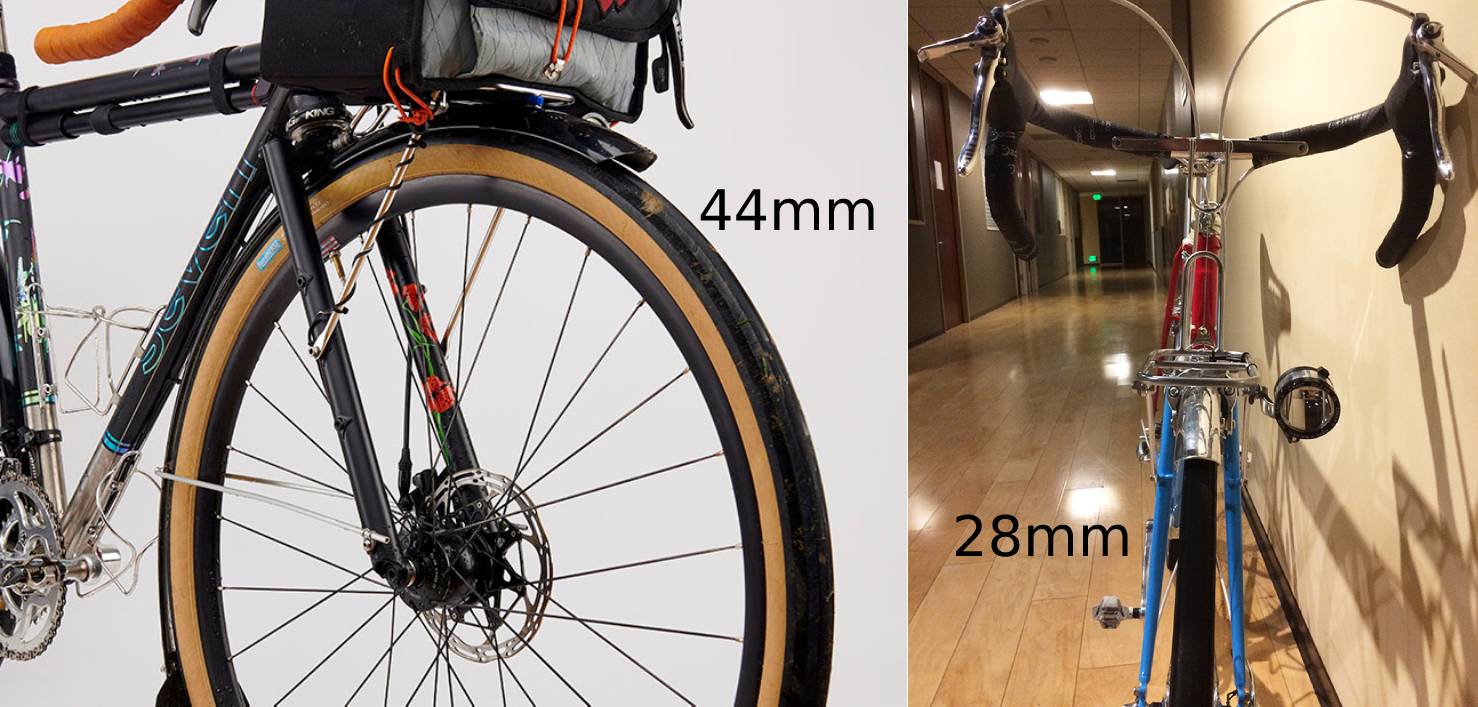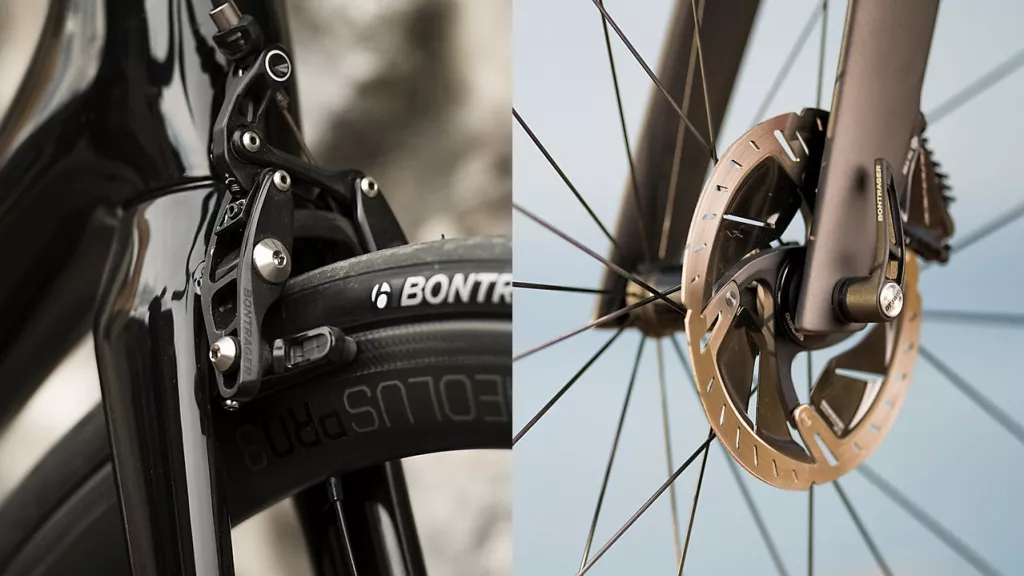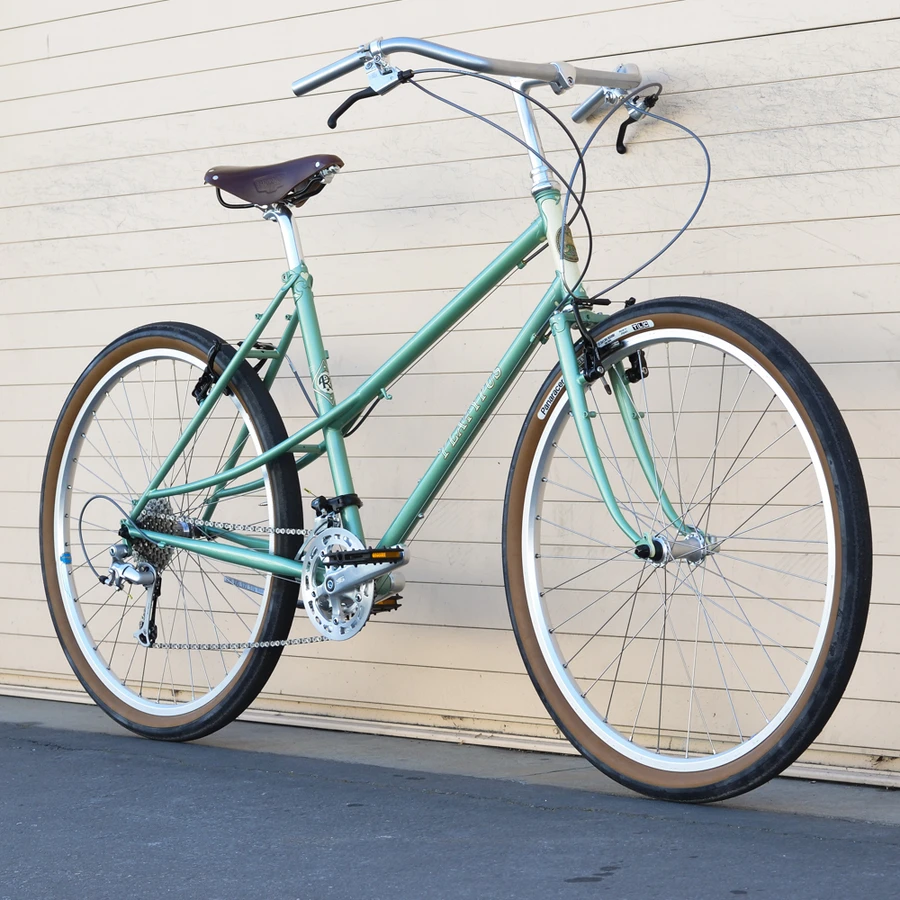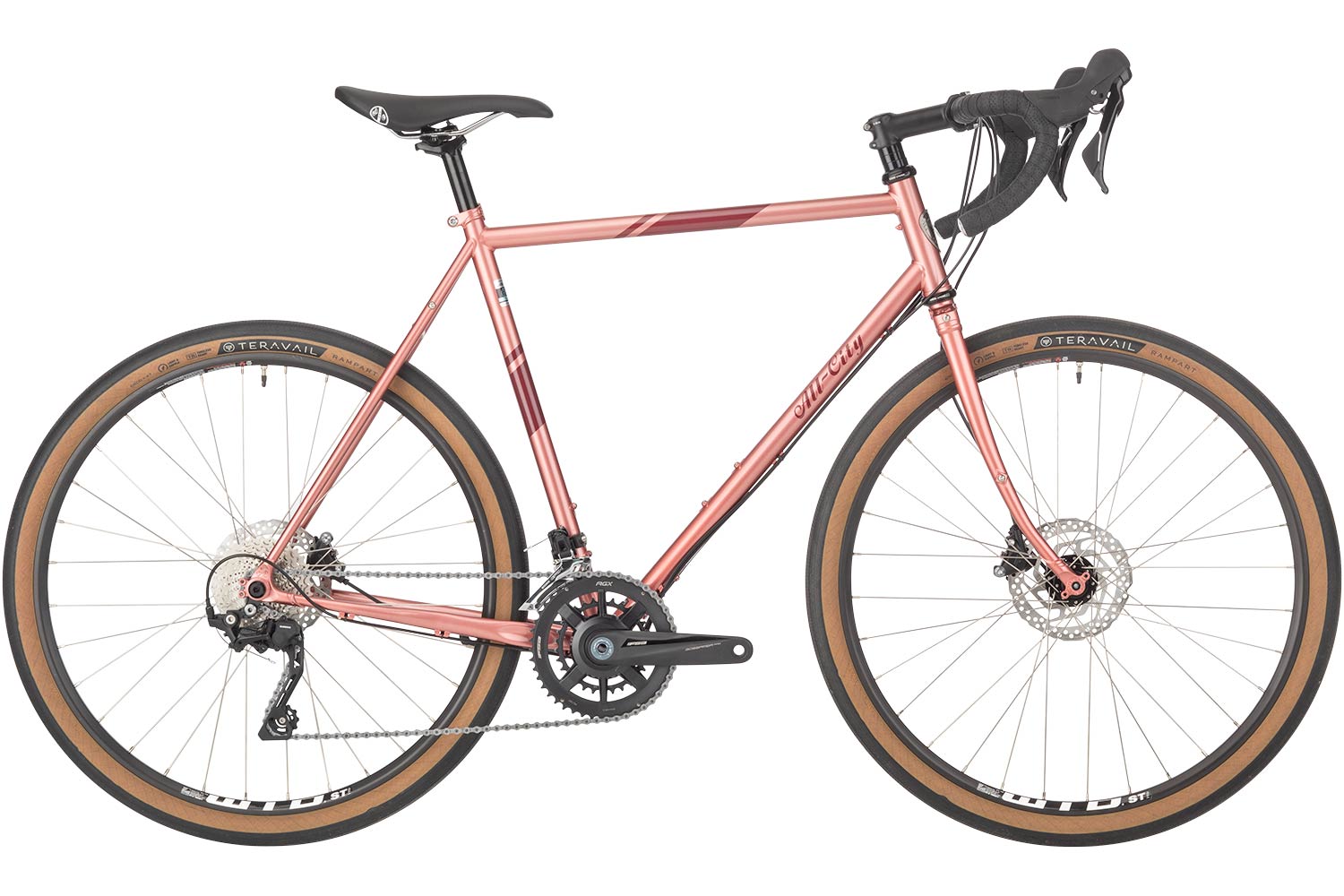For non-expert cyclists, I recommend steel road-ish bikes with wide tires. This post expands on this and also has tips for how to actually go about getting a bike.
Frame Material
There is a truly enormous diversity in bikes on offer, and steel bikes are somewhat out-of-fashion (though there is a thriving steel-bike subculture, and you can find many older “vintage” steel bikes for cheap as well).
Why steel? Well, you have four primary options for the material your bike frame is made out of:
- Aluminum is cheap and light.
- Steel is durable, and also fairly cheap.
- Carbon is ultra-light and expensive.
- Titanium is light, durable, and ultra-expensive.

Bicycle racing has produced a lot of people who think weight matters on bikes. It does in races, but weight isn’t a substantial factor for people who ride at normal speeds. Lots of the low-end aluminum bikes which have become so popular today are clones of racing bikes (thus tricking buyers into thinking weight matters).
Why does durability matter?
Well, you’re trusting your life to this thing. We as a society care deeply about safety in the form of durability in cars: if a car crumples too much when it’s in a collision, that’s an unsafe car and you don’t want it on the streets. I feel the same about bikes. Carbon bike frames are designed only for the loads in “normal riding” but not really for all the random things you might do by accident while owning a bike, like bumping it into walls, over-tightening the seat post, etc. People often tell you that if you crash your carbon bike, it might not be safe to ride anymore. This NPR article has some horror stories.
While aluminum frames are less likely to break if you over-tighten something, there’s still a decent amount of fragility with aluminum: a crack or dent can spread damage throughout the frame, causing it to eventually fail catastrophically.
Steel frames don’t have this problem. Steel is springy and bendy. If you dent it, you have a cosmetic flaw, not a risk to your life. If you bend it slightly, you can often just unbend it and be on your way. A steel frame may go out of fashion, or rust slowly over time, but it won’t fail catastrophically – you’ll see the rust well before you need to worry about it. Here’s a page from a well-known steel bike manufacturer, Rivendell, expanding on this.
Titanium frames are also quite durable, but I have never had the budget for a titanium frame and don’t have much knowledge about them.
Another thing to note about steel frames: there are a few different words that people use to refer to steel, by specifying which kind of steel. “Chromoly” or “Cromoly” is the broad name for the type of steel you want (it’s alloyed with chromium and molybdenum, hence the name). “4130” is another name for chromoly. This is generally the standard for decent frames; some lower-end bikes are made from “high-tensile” or “hi-ten” steel which is supposedly not as good but I don’t know exactly why.
Bike Categories
What will you use your bike for?
Here’s how I answer it: mostly road riding for exercise, but sometimes I venture on dirt roads or unpaved bike paths. Occasionally I even want to ride on a little bit of snow or mud. I want to be able to carry things regularly (grocery runs), sometimes lots of things (overnight trips with a tent), but other times I’m riding with friends and don’t want to feel like the bike is slowing me down. I’m planning on leaving it locked outside in the city for an hour or two at a time, so if it looks too expensive then that will stress me out. I also want to be able to occasionally ride in the rain without getting soaked.
The things that a typical bike person will pick out from this are: 1) support for dirt roads and rough terrain; 2) support for racks and fenders. They will then recommend an off-road touring bike. This is actually fine as a starting place - the only thing that frustrates me about the process is that not many companies actually make off-road touring bikes and there’s not a huge selection. What they miss is: I don’t need it to excel in the mud or snow, I just need it to have wide enough tires to work. Also, any bike that can take a front and rear rack will work - a “touring bike” is specially designed not just to have racks but to ride well while loaded, but there’s no reason you can’t put rack mounts on any steel bike (although it’s a tricky thing to do aftermarket, so best to look for a frame that already supports it).
Anyway, based on my requirements, I’ve found that I tend to be looking at bikes in the following categories: endurance road; randonneur; road plus; all-road; gravel; cyclocross; touring (light, on-road, off-road); adventure; hybrid; comfort; commuter. These mostly tend to fall into the broad “road” bucket if you have to choose between mountain and road bikes.
If you have different requirements from me and are shopping for a bike, it’s a good idea to peruse the categories over at BikeInsights and see what matches what you’re looking for!
Tires
Copying racing bikes drives a ton of fashion trends in cycling – we see racers riding super skinny tires, and copy that. Fortunately, this trend is changing quickly – “gravel bikes” are a new hot thing in the mainstream cycling world, and gravel bikes have wider tires than traditional road bikes – but you’ll still see people selling road bikes that can only take skinny tires.
If you chose a mountain category, congrats! You can skip this section, your tires are wide already. Otherwise, read on for my road bike tire preferences.
Quick primer: There are three major wheel diameters – 26”, 27.5” (also known as 650b) and 29” (also known as 700c). You’re unlikely to see 26” on a road bike (it’s an older mountain bike thing). Most road bikes are 29”/700c, although some newer and/or smaller road bikes use the 27.5”/650b size.
When choosing a road bike frame, I think most casual cyclists should consider 35mm the minimum tire width they will tolerate, and ideally choose a bike that can take tires closer to 45mm.

Why wider tires? They’re more comfortable to ride on, and they can handle tough terrain much better than skinny tires – and you make virtually no trade-off choosing a wider tire.
No trade-off, really? Some people think wider tires are slower. This does not actually seem to be true at normal cycling speeds, based on testing done by a company that sells tires of many sizes. It may be true at racing speeds, or with certain configurations of bikes – follow the link if you want the details, but short version, they’re the same speed, or close enough that you’ll never notice.
One reason there’s a rumor about wider tires being slower is this: skinnier tires are pumped up to higher pressures. This causes them to transmit vibrations from the road, which results in an illusion of speed. So, when switching from a wide-tire bike to a skinny-tire bike, a lot of people experience an immediate sense of “gosh this just feels so much faster” and they index heavily on that feeling.
Regardless, if you want to be able to occasionally ride bumpy terrain such as dirt roads, it’s an extremely good idea to have tires where that won’t suck. Skinny tires are just incredibly unpleasant on such terrain – the rigidity of the tire transmits all the bumps directly into your body. Even if you don’t plan to ride dirt roads or grass very often, I feel like one ride in three in my area runs into some terrain of this sort unless I’m very careful to avoid it.
So generally, you should run the widest tires your frame can take given other constraints. Fenders, for example, reduce tire clearance by a few mm but tend to be worth it for the kind of riding I do (sometimes I ride in the rain), and I’m happy to use slightly smaller tires in order to fit fenders.
Brakes
This is far less important than the frame and tire sections, but figured I’d mention it. I really like disc brakes.

“Rim brakes” are the traditional way bike brakes work: attach some brake pads to a lever mounted on the frame near the edge of the wheel, then squeeze the pads against the rim of the wheel.
“Disc brakes” are the new way, and are more similar to how cars and motorcycles stop: a single-purpose metal braking disc is attached to the wheel, and there are some “calipers” attached to the frame that mate with the disc. Squeezing the lever squeezes the calipers, and the wheel stops.
(“Coaster brakes” are a system seen usually on low-end or kids’ bikes; you pedal backwards to brake. If you are reading this and buying a bike, you probably aren’t considering coaster brakes. They don’t tend to have strong braking force.)
I’ve used both rim brakes and disc brakes quite a bit now, and I’ve found disc brakes to be a lot more reliable. Rim brakes are fiddly: you can easily adjust them wrong and have no braking power. Disc brakes are a lot harder to screw up since they’re more self-contained. I think for this reason, many new road bikes are starting to come with disc brakes, but you’ll still see a lot of new rim-brake bikes, and this is a fairly new trend so if you’re looking at older used road bikes you’re probably looking at rim brakes.
There are plenty of reasons rim brakes can be a valid choice, and I wouldn’t necessarily weight brake type too heavily on my next bike–if there were other things I wanted that were only available with a rim-brake frame, I’d get rim brakes. Some people prefer the aesthetics of rim brakes.
Some fancy bikes use hydraulic cables instead of regular mechanical cables to transmit the braking force from your hands. I haven’t tried this, but I’ve heard that it is annoying because you have to maintain the hydraulic system in fiddly ways. I recommend sticking with mechanical disc brakes for now.
Feel and aesthetics
You should pick a bike that feels good to ride, and you may also care about how it looks (I know I do). All my recommendations are very weakly held in this section!
- Pick a bike frame that you can ride for hours comfortably. There are a ton of parameters that go into the fit of a bike. If you already have a bike you like, a tool like BikeInsights may help you determine if another bike you’re considering is similar in fit (though they don’t have every bike, especially not older models).
- In particular, frame size matters a lot – if you have long legs you will probably want a bigger frame. It’s hard to know ahead of time without trying a few frames which size will fit you – your height is a rough guide, and most bike manufacturers have sizing charts so you can map your height to your frame size. Some manufacturers prefer to size based on “PBH” or pubic bone height (basically leg length).
- Frame geometry matters a little bit: I like more upright bikes because I don’t like craning my neck when in the drops, just to see the road in front of me. There’s a lot of subtlety here, especially in how it interacts with fit. However, you don’t need to think too hard about this if this is your first bike, because there aren’t any great ways to know what you’ll like besides owning a bike and riding it for a while. So first step is to just get something that’s approximately the right size, and plan to tweak the fit on your next bike.
- Handlebars affect the feel dramatically. Drop vs. flat, how wide they are, how much drop/rise/sweep, all these things are worth playing with. I like wider drop bars.
- Pedals affect the feel a decent amount too. I like grippy flat pedals – they have these small pins that stick up from the pedal surface and grab the rubber of your shoe.
- Steel frames have skinnier tubing than aluminum or carbon and this has a pretty big aesthetic impact.
- Your drivetrain (front and rear gears, pedals and chain) has a pretty major impact on the aesthetics. A single-speed drivetrain looks very clean; certain silvery chainrings look very retro/vintage whereas I think black parts look more modern. A “1x” (single front chainring) drivetrain looks clean compared to having multiple chainrings and a front derailer. Whether or not you use toe clips has an impact on the look too.
Budget and bang for your buck
If you only have $100-300, you should be looking used on Craigslist, etc. You can filter for steel in the “frame material” section of Craigslist. Beyond that you don’t get to pick much about your bike - you may have to take whatever is available and you won’t be able to afford much in the way of component upgrades. These bikes are functional (and may be all you can get if you’re worried about bike theft). My first bike was a $225 Craigslist clunker, and it worked great.
There are some decent low-end new options at the $300-600 level, like State. Used bikes are a decent option here too but it tends not to be worth shipping a bike at this price, so you have to get a little bit lucky with a used bike you want becoming available in your area.
Around $600-1400 is midrange new and great used, and here there are a good number of options. Again, used bikes tend to be great bang-for-the-buck. The nice thing about this range is that it starts being worth it to ship the bike, so you can buy used from outside your local market. I bought a used bike I’m incredibly happy with for $1250 plus shipping on Pinkbike. A friend bought a similar one for $800 on Craigslist. This price range feels the “sweet spot” to me.
High-end new complete bikes tend to cost closer to $1500-2000. At this level, you should get great components, a great frame, and a generally really well put-together bicycle.
Above that you are in “custom build” territory. A custom builder I like (Analog Cycles in Vermont) quoted me $2800 for a pretty amazing-looking build, and the great thing about this plan is that you can select every component. I didn’t end up taking this offer because I found a similar used bike that I liked almost as much for half the price – but if you want everything set up exactly how you like it, and aren’t budget conscious, this is a good plan.
Now, it’s a bit hard to learn everything you need to know about component selection – there are quite a lot of choices, and pervasive marketing efforts intended to get you to pay more money. Basically, there are 3 major drivetrain component manufacturers: Shimano, SRAM and Campagnolo. They all do this branding thing where they have different price tiers of components, with the implication that as you pay more you get more quality, durability, lighter weight, etc. I think this is kind of true, but I don’t actually know where the sweet spot truly lies. I have a feeling that bike buyers often over-index on this, and it’s very easy to get sucked into buying based on the marketing rather than what you actually need. I have no non-obvious strategies to avoid this – now you know it exists, you’ll have to either trust whoever is building your bike, or do your own research separately from whoever is trying to sell you a bike.
My favorite brands of bikes:
- All-City is my favorite bike brand, probably because they hit everything I’m looking for, and have an extra emphasis on beauty that most other companies don’t. (Although, some of their forks are carbon instead of steel, which I don’t love.)
- Surly has a very strong reputation for durable steel bikes with great tire clearance.
- Soma makes great affordable frames, but they don’t make complete bikes as far as I know. My $1250 used bike is a Soma.
 Rivendell makes higher-end, beautiful vintage-style frames and will put together a complete bike for you, if you want them to. These folks are incredibly opinionated about bikes and it’s a lot of fun to read their blogs and books. They have a very strong cult following. They don’t make disc brake bikes though.
Rivendell makes higher-end, beautiful vintage-style frames and will put together a complete bike for you, if you want them to. These folks are incredibly opinionated about bikes and it’s a lot of fun to read their blogs and books. They have a very strong cult following. They don’t make disc brake bikes though.- Kona makes nice complete bikes. Not all are steel frame, so if you want that just make sure you pay attention to what you’re buying!
- Velo Orange makes lovely frames with a focus on touring – tons of ways to hang bags and such off your bike.
That said, if you find a bike you like that isn’t one of these, go for it! Bikes from these brands tend to be sought-after and thus pricey, but you can find or build a great bike from non-brand-name frames as well.
How to actually buy a new bike
So, I haven’t done this myself. Most of my favorite bike makers don’t sell direct to you. Typically, you have to find a local bike shop that has a relationship with the manufacturer, and work with them.
I don’t actually know why this state of affairs persists, because it seems pretty non-optimal in the age of COVID. Some manufacturers can do “bike shop direct to home” - which is to say, you still have to call and order it through a bike shop, but they can have the manufacturer send you the complete bike directly so you don’t actually have to go to the bike shop to get it.
A company called BikesDirect makes a very wide variety of bikes, mostly in China, and they will ship to your door. This website has a surprisingly good reputation given how sketchy-looking and hard-to-navigate it is – you won’t be able to try the bike before you buy it, but if you know kind of what you’re looking for and aren’t too fussed about aesthetics then it might be a decent option. I haven’t ridden these bikes.
State, mentioned above, also makes decent-looking new bikes that they will ship to you, at good price points, and I think they are also quite pretty. They have a love/hate reputation and I haven’t ridden one, so do additional research.
Buying used
I like to browse Craigslist and Pinkbike; you may also look at Facebook Marketplace, Kijiji, etc. Set minimum and maximum price filters, and if you can, filter by frame material to limit to steel bikes. (Pinkbike also has a “chromoly” option which some people choose when listing their bike, so on that site you should check that box also.) For me, pinkbike is particularly great because it also has a frame size filter.
If you’re in the $800-1400 range, your bike seller should list the brands of the major bike components. If you can’t evaluate these components well on your own, send the posting over to a friend who knows about bikes (or post it on reddit - I think there are places over there where people will tell you whether a used bike is a good deal or not).
Generally, you can negotiate the price with seller. You can usually get 10-20% off the list price, and (in my experience) they hate negotiating as much as I do. The used bike I bought was listed at $1400, I asked “hey will you accept $1200 for this” and they countered with $1250. My seller also split shipping with me (came out to roughly $120, I think).
from Hacker News https://ift.tt/lGeEM5u

No comments:
Post a Comment
Note: Only a member of this blog may post a comment.